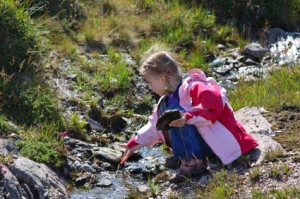Water is essential to human life. Man can survive weeks without food, but only mere days without water. 
Unfortunately, water is also heavy.
It might be possible to carry enough water with you for a short overnight camping trip, but a longer trip, one where you’ll need water for cooking, cleaning, and drinking, requires you to find water in the wild.
Most campgrounds or campsites offer potable drinking water, and some even offer shower facilities. Make sure the water is marked potable before you use it for drinking or cooking (unless the water is going to be boiled in the cooking process). Non-potable water can still be used for for showering and washing clothes.
If the campground doesn’t offer potable water, or if you’re camping in the wilderness, there are several ways to solve your water problems.
A water filter can provide enough water for several people. Water is pumped out of a natural source, passes through a filter, and then collects in a container. The filters are capable of removing foreign elements (such as parasites) and bacteria. The newest filters can even remove viruses. Pumping does take a considerable amount of time, and the filters need to be replaced regularly.
Iodine, either in a crystal or tablet form, can be used to purify water. However, it does not kill all of the pathogens found in water, and does not remove foreign elements the way that filters do. Specifically, it’s not effective against the parasite Cryptosporidiosis, which causes diarrhea. Usually only an annoyance, Cryptosporidiosis can be fatal to people with compromised immune systems. Iodine is an easy, convenient solution, but doesn’t provide the level of purification that filters do.
Various chlorine based tablets can also be used to purify water. They are generally more effective than Iodine tablets in preventing Cryptosporidiosis and Giardia, which also causes diarrhea, but they still don’t offer 100 percent protection.
Finally, silver ion/chlorine dioxide based tablets or droplets can be used. They are more effective than either iodine or chlorine based tablets at purifying water of Cryptosporidiosis and Giardia.
One major drawback to all the chemical purification processes is the time required to purify the water. Iodine tablets take approximately 30 minutes to purify clear warm water, but take considerably longer to purify hazy or cold water. Chlorine based tablets normally take between 30 and 60 minutes. Silver ion/chlorine dioxide based tablets can take up to four hours.
It is also possible to use ultraviolet (UV) light to purify water. Exposure to it damages microbial DNA, making it impossible for the microbes to reproduce, and therefore making them less virulent. However, the water cannot be exposed to visible light after treatment, or the damage may be reversed. Also, different microbes have different sensitivity to UV light, so it’s not effective against everything. Giardia, in particular, is not removed by this method. UV purification can be combined with a filter purification method for more coverage.
Solar purification is also useful. This method uses a still and visible light to cause water to evaporate (removing the impurities) and then reform in a separate, clean container.
Of course, when all else fails, or when you don’t have a fancy filter, chemical tablets, a UV light, or the means or knowledge to make a still, there’s always the tried and true method of boiling water to purify it. Most experts recommend that you boil water intended for drinking for five minutes. Add an additional minute for every 1000 feet in altitude above sea level. Also, don’t mistake a mild simmer for a boil. The water should be at a roiling boil for the entire time.
Common sense is also useful when it comes to finding water in the wilderness. Fast moving water is safer than still water, water that looks clear is probably cleaner than water that looks hazy, and it’s never a good idea to drink downstream from a large chemical or industrial plant.